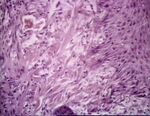Difference between revisions of "Granulation Tissue"
Jump to navigation
Jump to search
(Created page with "thumb|right|150px|Granulation tissue (Courtesty of BioMed Archive) * Is completlely different to [[Granulomatous Inflammation|granulomat...") |
|||
| Line 10: | Line 10: | ||
* Ulcers and open wounds may heal by granulation. | * Ulcers and open wounds may heal by granulation. | ||
| − | + | [[Category:Chronic Inflammation]][[Category:To Do - Blood]] | |
| − | [[Category:Chronic Inflammation]][[Category:To Do - | ||
Revision as of 11:29, 4 August 2010
- Is completlely different to granulomatous inflammation, despite the similarity in name!
- Occurs on the surface of the skin where large areas of the epithelium have been lost.
- Makes up the lining of sinus tracts discharging from deeper lesions.
- Takes its name from the gross appearance of the small vessels which appear at the surface.
- Look like red granules.
- These vessels supply inflammatory cells, mainly neutrophils, to the infected surface.
- The most frequent example in domestic animals is the formation of excessive granulation tissue on the legs of horses with poorly healing wounds.
- "Proud flesh"
- Ulcers and open wounds may heal by granulation.
